There are a handful of places that resonate as must-visit for every American, and among them, certain sites stand out. Pearl Harbor, with its profound historical significance, and the Freedom Trail in Boston are iconic destinations etched in our national memory.
However, one spot that holds a special place is Washington, DC, and more precisely, the National Archives Museum.
Here, amidst the nation’s capital, you can lay eyes on the very founding documents that shaped our country.
In this article, we’ll take you on a virtual tour of the Rotunda at the National Archives Museum, offering insights into the enriching experience it has to offer.
What is the Rotunda at the National Archives Museum?
Nestled in the heart of the National Archives Museum in Washington, DC, lies the iconic rotunda, housing the nation’s most cherished documents.
Among its prized possessions are the Declaration of Independence, the US Constitution, and the Bill of Rights, accompanied by a trove of other captivating historical papers.
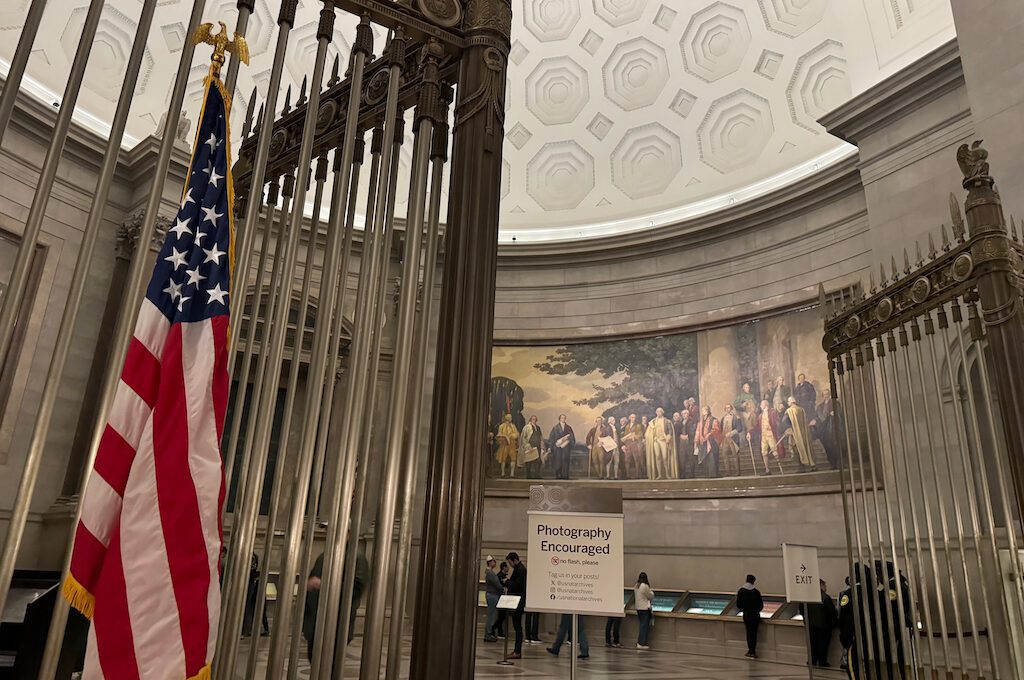
The National Archives building is a remarkable architectural achievement.
Completed in 1937, it showcases 72 Corinthian columns, each standing at an impressive 53 feet in height and with a diameter exceeding 5 feet.
Welcoming visitors are two monumental bronze doors at the entrance, measuring over 38 feet in height and nearly 10 feet in width. The pediments on the building’s sides span an impressive 118 feet, making them the largest in Washington, D.C.
To appreciate the entrance up close, ascend the steps, though note that the official entrance is located on the side, marked by clear signage. No tickets are needed to get in and it’s free to visit.
As you approach the National Archives Museum, you’ll find folks queued up around partitions, especially during the busy summer months.
However, when my visit rolled around in November, the lines were pleasantly absent, sparing us any crowd-related hassles. With that hassle-free entry, we strolled into the exquisitely designed rotunda.
Architect John Russell Pope envisioned the National Archives as more than just a repository for historical documents. He aimed to create a space where people could reflect on the essence of American identity.
Pope carefully designed the shrine to exude the grandeur befitting the nation’s foundational documents, turning it into a symbolic tribute to American democracy.
Speaking of symbolism, check out the symbolism sprinkled all around the rotunda. The medallions on the gates sport either mercury or Medusa, symbolizing wisdom or protection, depending on how you interpret it.
Those gates? They’ve got spears running through them, topped with eagles standing guard over the charters of freedom.
And don’t miss the hefty medallion on the floor, split into four sections that encapsulate the essence of the American government’s mission. Keep your eyes peeled for other subtle symbols—they’re scattered all over the place.
Upon your visit, you’ll immediately sense the deliberately cool temperature and subdued lighting, implemented to mitigate the potentially harmful impact of heat and light on the invaluable records.
Inside the Rotunda, the lighting is adjusted to match the glow produced by two candles positioned one foot away—a measure referred to as “foot candles.”
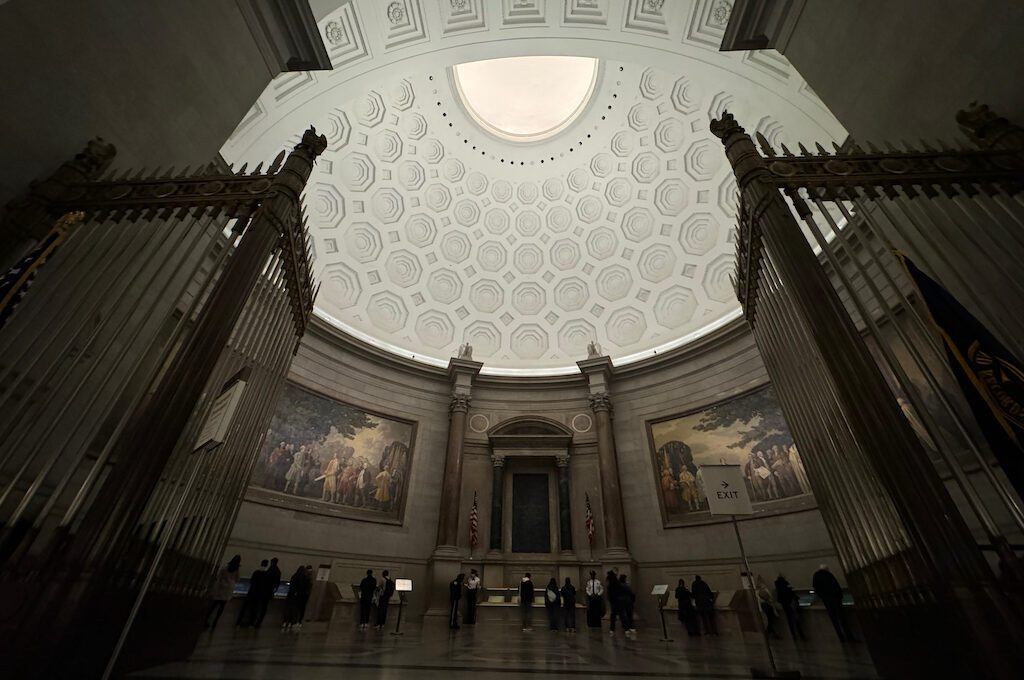
Ensuring the utmost preservation, the Charters of Freedom reside within closely monitored cases filled with protective gas, safeguarding these historic documents with precision and care.
Adorning the walls are expansive Faulkner Murals narrating the tale of pre and post-independence, portraying fictional scenes of pivotal moments like the presentation of the Declaration of Independence and the Constitution.
These striking murals were crafted by Faulkner in a spacious room above Grand Central Station in New York City. With precision, they were then transported to the National Archives and skillfully installed on October 15, 1936.
Standing at an impressive 14 x 37.5 feet, these larger-than-life murals undoubtedly capture the attention of Rotunda visitors. And for an extra layer of intrigue, be sure to scrutinize the mural on the right—there’s a concealed profile of none other than President Abraham Lincoln waiting to be discovered.
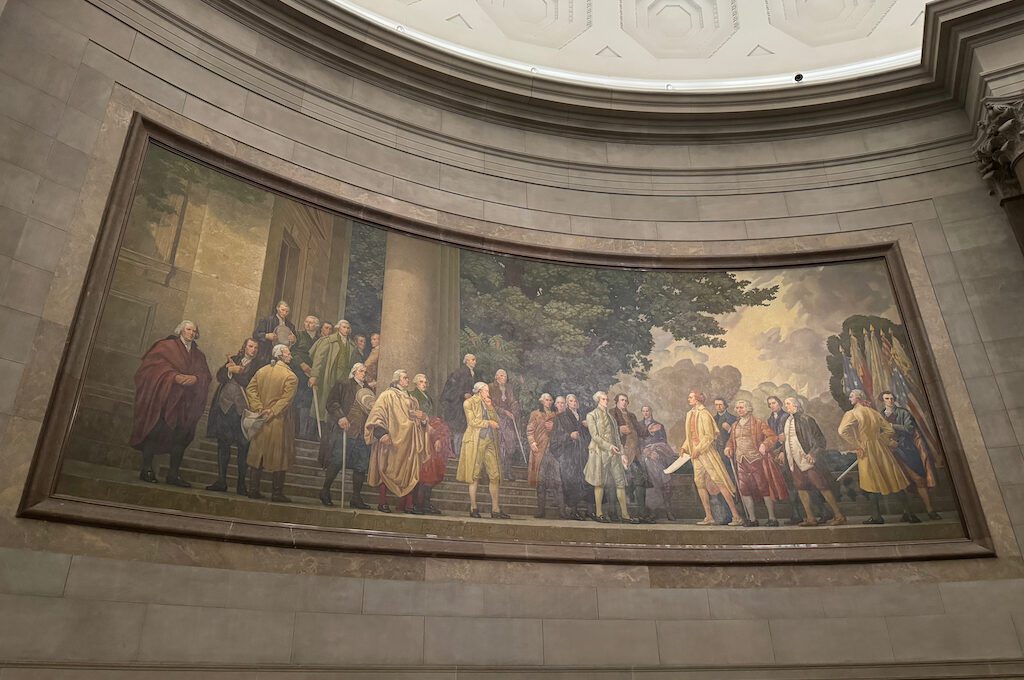
Once you have had a moment to take in the magnitude of the rotunda then it’s time to check out the documents.
Begin your journey on the left, where historical gems like the Senate Journal of the First Congress of the United States of America and Proclamation Suppressing Rebellion and Sedition where King George III referred to our founding fathers as “dangerous and ill-designing Men.”
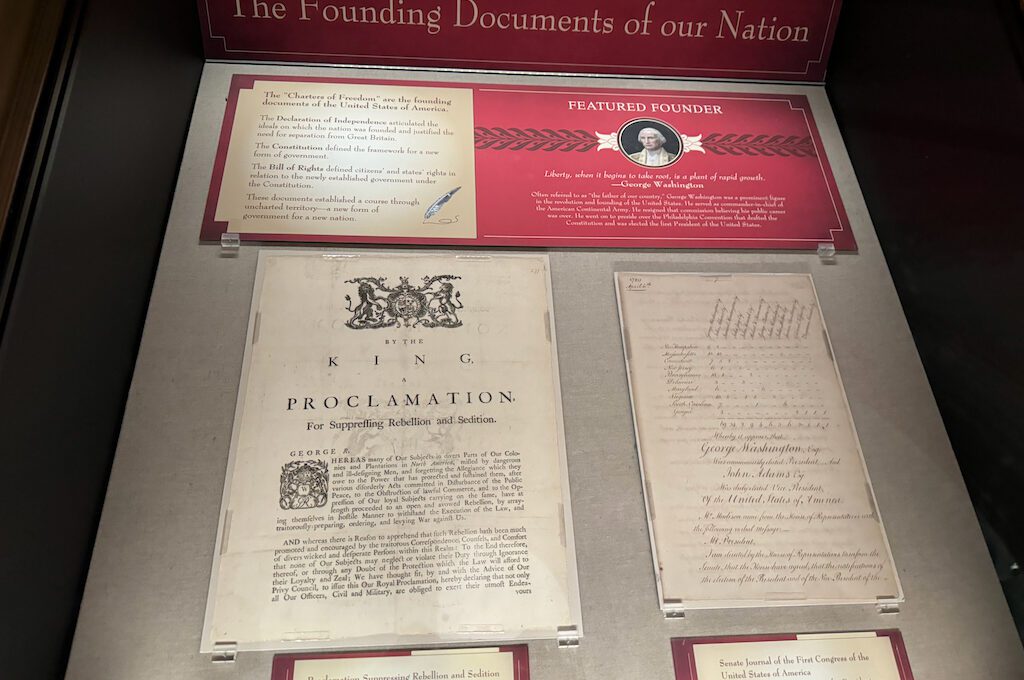
As you progress toward the center, the excitement builds and the focal point emerges—the venerable Declaration of Independence.
The Declaration of Independence was adopted by the Continental Congress on July 4, 1776.
However, the actual signing of the document by most delegates occurred on August 2, 1776, The text you (barely) see today was likely engrossed (written in clear, large lettering) by Timothy Matlack, an assistant to the Secretary of the Congress.
As you ponder these iconic documents, you might be tempted to conjure up a Nicholas Cage moment, reminiscing about “National Treasure.” The urge to crack a related joke with the security agents may cross your mind, but rest assured, they’ve heard them all before….
Reading the faded lettering in the somewhat dim light isn’t always easy, but you can still decipher some of the legendary text.
Signs urge visitors not to snap photos of the founding documents, including the Declaration of Independence. This restriction aims to manage the crowds, preventing the slowing down of the experience with thousands of daily snapshots.
When things are calmer, the guards might be cool about you taking pictures to capture your own memories. It’s worth noting that there’s no strict order you have to follow when checking out these documents.
Feel free to explore at your own pace, but just try to remain mindful of others and not linger too long. Remember, you can always circle back to take another look at any time.
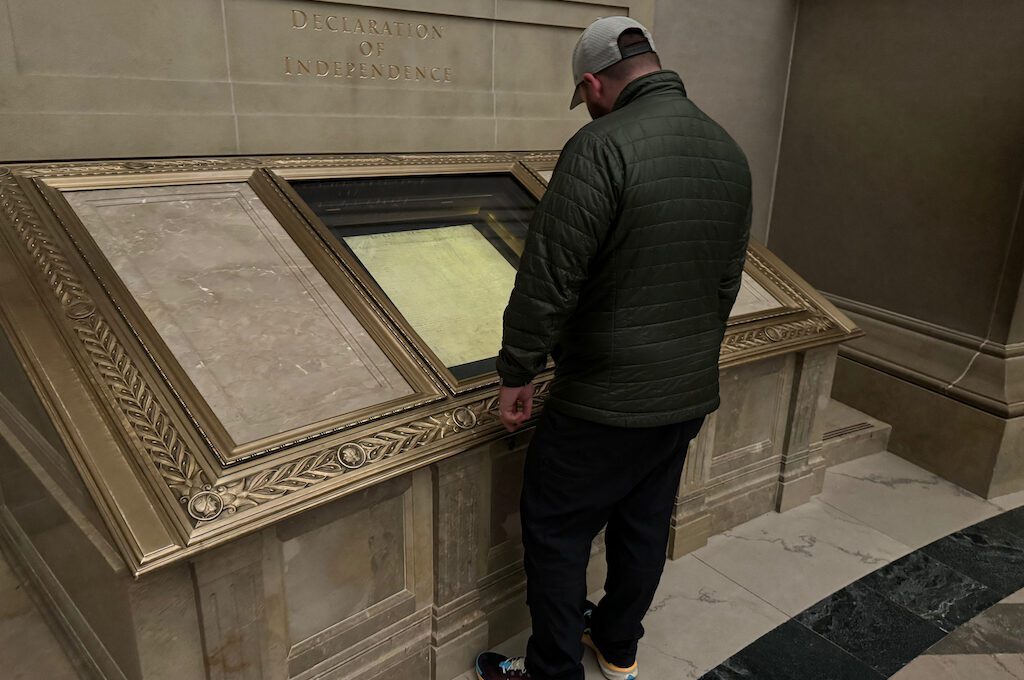
Nestled in the heart of the exhibit, right at the midpoint, are four pivotal pages of the Constitution. It’s a concentrated dose of foundational text, where the essence of the nation’s guiding principles is distilled onto those carefully preserved sheets.
These four large sheets of parchment were copied from a prior draft in 1787 by Jacob Shallus, the assistant clerk for the Pennsylvania General Assembly. It took him a whopping 40 hours to express the terms in a fine, clear hand and he was paid $30 for his efforts.
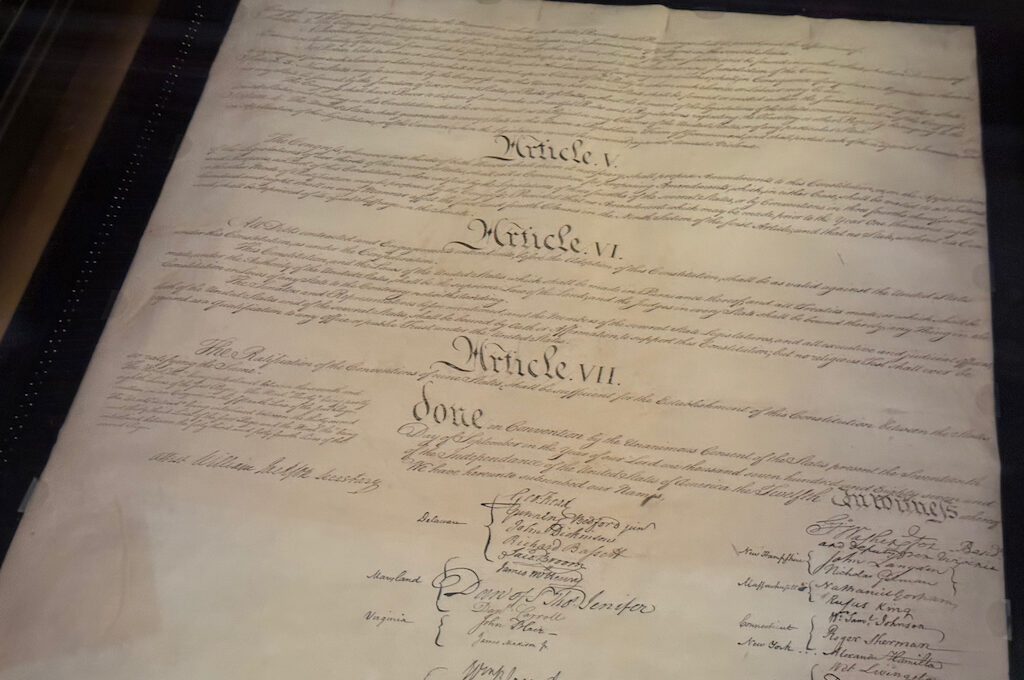
And, of course, there’s the Bill of Rights, the cornerstone that bestowed upon us amendments crucial to our constitutional fabric. Take a closer look, and you’ll encounter transformative amendments such as the First Amendment, safeguarding freedom of speech, religion, and the press.
There were 14 handwritten copies of the Bill of rights made by William Lambert and Benjamin Bankson, engrossing clerks for the House and Senate and a copy was sent to each state for ratification. The version on display here is the federal government’s copy, although they also have Delaware’s copy somewhere in the museum.
Following a viewing of these documents, there’s more to explore. During our visit, we saw the Monroe Doctrine, a diplomatic milestone in American history that asserted the nation’s stance on foreign policy. And there are other gallery areas with interesting exhibit and artifacts like the New York Fire Department jacket George W. Bush wore when he threw out the first pitch at the iconic Yankees game after September 11.
Final word
The National Archives is a standout feature of the Washington DC experience. The fact that all these significant documents are not only preserved but also available for the public to see in one place is truly remarkable. It’s a unique and special opportunity, and standing amidst these historical records can evoke a sense of pride in being an American.
Daniel Gillaspia is the Founder of UponArriving.com and the credit card app, WalletFlo. He is a former attorney turned travel expert covering destinations along with TSA, airline, and hotel policies. Since 2014, his content has been featured in publications such as National Geographic, Smithsonian Magazine, and CNBC. Read my bio.

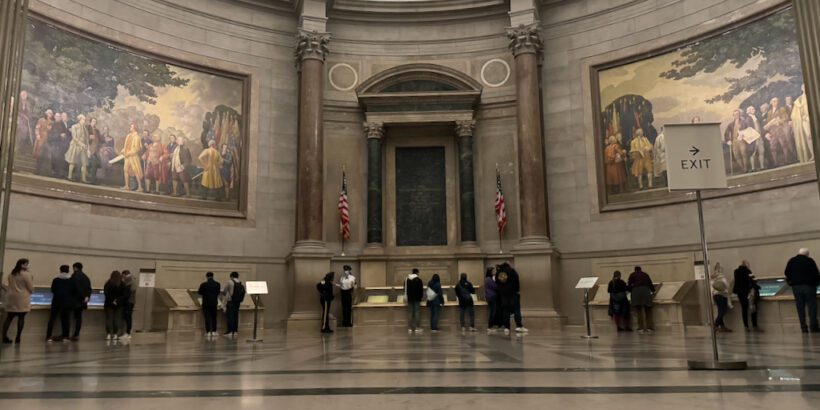
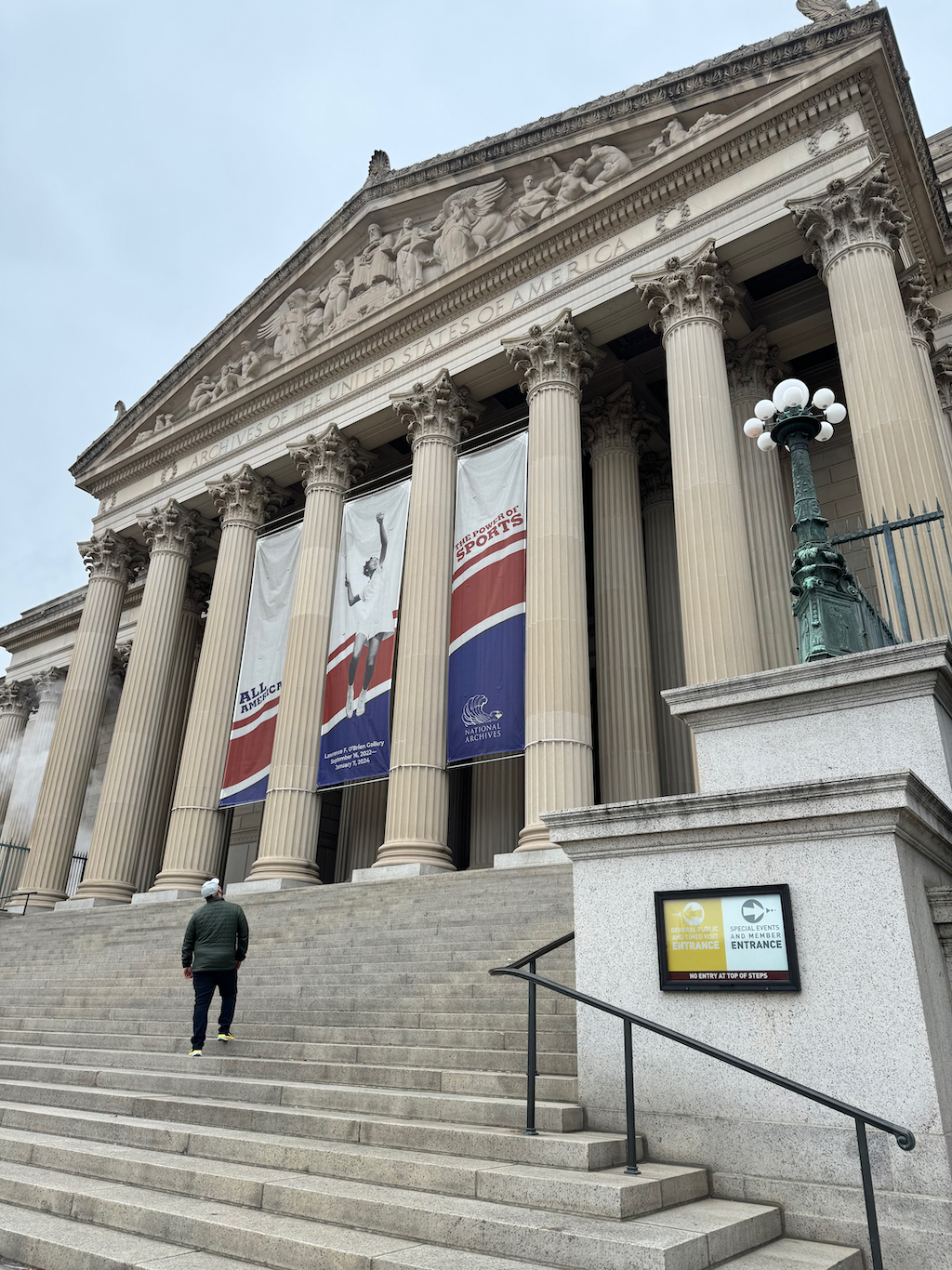
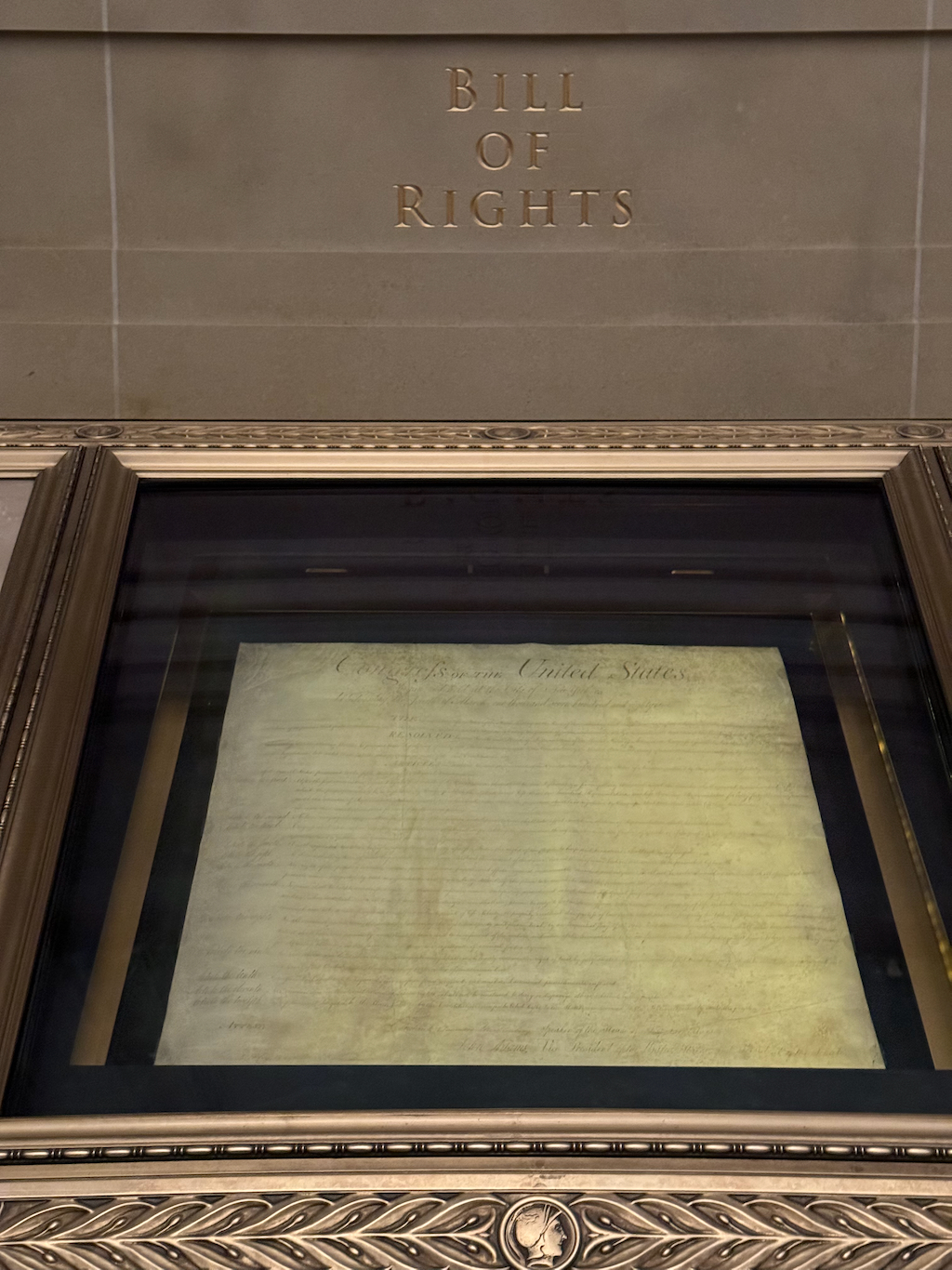
You might consider mentioning that the dome above the rotunda is a masterpiece by Rafael Gustavino (https://aotus.blogs.archives.gov/2011/06/22/guastavino-vaulting/). Another example is the vaulted ceiling of the National Academy of Sciences at Constitution Ave. These domes are made from self-supporting terracotta tiles the he had patented in 1885. Worth looking into!